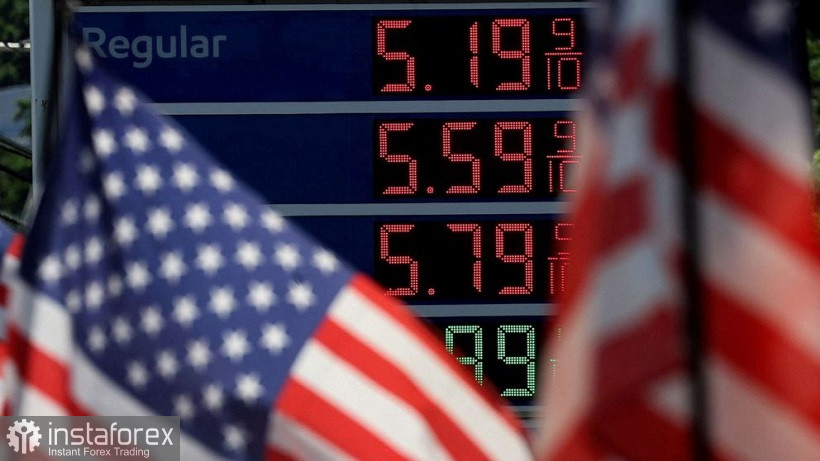The euro-dollar pair is phlegmatically declining, trading within the 97th figure, after a sharp 250-point decline last week. The downward dynamics slowed down ahead of important inflation reports. Note that on Wednesday, the US producer price index will be published, and on Thursday—the consumer price index.
Despite the relatively passive position of the bears, buyers are also in no hurry to rush into battle: longs look too risky against the backdrop of fairly strong non-farm payrolls report, published Friday. The ISM Services Index, which came out in the "green zone" last week, also supported the greenback. Therefore, market participants found themselves in a stalemate at the start of the new week: both sellers and buyers of EUR/USD need an additional newsbreak to decide on the vector of further price movement.
In my opinion, the situation will develop in favor of the US currency in the near term, as the flywheel of inflation will only spin up. According to some experts, the latest developments in the oil market will hit the pockets of many Americans quite noticeably. Last week, OPEC+ members decided to reduce the production of "black gold" by 2 million barrels per day. The resonant decision was made by the Cartel despite pressure from the United States. After all, the expected consequences of such a step are negative for the United States (and the consequences are not only economic, but also political).

First, the decline in oil production will affect the cost of gasoline in the United States. According to preliminary calculations, it will rise in price by 30–50 cents per gallon. Secondly, the OPEC+ decision will hit those US residents who independently heat their homes in winter. Fuel oil, which is used for individual heating in the United States, will rise in price. For US President Joe Biden, and the Democratic Party as a whole, this is bad news, since the Cartel made its odious decision on the eve of the November congressional elections. According to CNN, it will be extremely difficult for Biden to solve this problem, "given the poor relations of the White House with representatives of the American oil industry." In turn, JP Morgan sources report that Washington may take countermeasures by freeing up additional oil reserves. However, how effective these responses will be is an open question.
Rising fuel prices are also bad news for the Fed, which is trying in vain to curb inflation. The rise in fuel prices will pull along many other components, which will affect the dynamics of the consumer price index. We will most likely see the echoes of the OPEC+ decision in November–December (if the Biden administration does not stop this problem). But the dollar may receive additional support as early as this Thursday if September inflation exceeds forecast levels. Moreover, experts' forecasts are quite bold: according to most analysts, the general consumer price index will rise to 8.1% in annual terms, and will grow by 0.2% in monthly terms. The core CPI, excluding food and energy prices, could jump to 6.6%. If the core index comes out at least at the predicted level, it will update the 40-year high, thereby strengthening the positions of dollar bulls.
But the euro is not able to reverse the situation in its favor. And although inflation in the Eurozone in September once again updated its historical record, reaching the target of 10.0%, this fact turned out to be essentially useless for EUR/USD buyers. The rhetoric of the ECB representatives tightened even before the publication of the latest inflation data. Back in September, many representatives of the European regulator announced that at the October meeting it was necessary to consider the option of a 75-point increase. Therefore, this fundamental factor is already largely taken into account in prices. For example, speeches by ECB representatives—Bundesbank President Joachim Nagel and ECB chief economist Philip Lane—are expected today. In the light of recent releases, they will certainly sound hawkish rhetoric. However, this fundamental factor is unlikely to affect the EUR/USD pair, even in the context of a corrective pullback.
But the increase in geopolitical tensions will only increase the demand for a safe greenback. Anti-risk sentiment in the markets is growing again, supporting the dollar bulls.
Thus, several fundamental factors play in favor of EUR/USD bears at once. The technical side of the issue also speaks about the priority of short positions: on the daily chart, the price is located between the middle and lower lines of the Bollinger Bands indicator, as well as under all the lines of the Ichimoku indicator, which shows a bearish "parade of line" signal. The first, and so far the main target of the downward movement at the moment is the 0.9570 mark (the lower line of the Bollinger Bands indicator, on the D1 timeframe). If this target is overcome, it will be possible to talk about a decline to the base of the 95th figure.
 English
English 
 Русский
Русский Bahasa Indonesia
Bahasa Indonesia Bahasa Malay
Bahasa Malay ไทย
ไทย Español
Español Deutsch
Deutsch Български
Български Français
Français Tiếng Việt
Tiếng Việt 中文
中文 বাংলা
বাংলা हिन्दी
हिन्दी Čeština
Čeština Українська
Українська Română
Română

